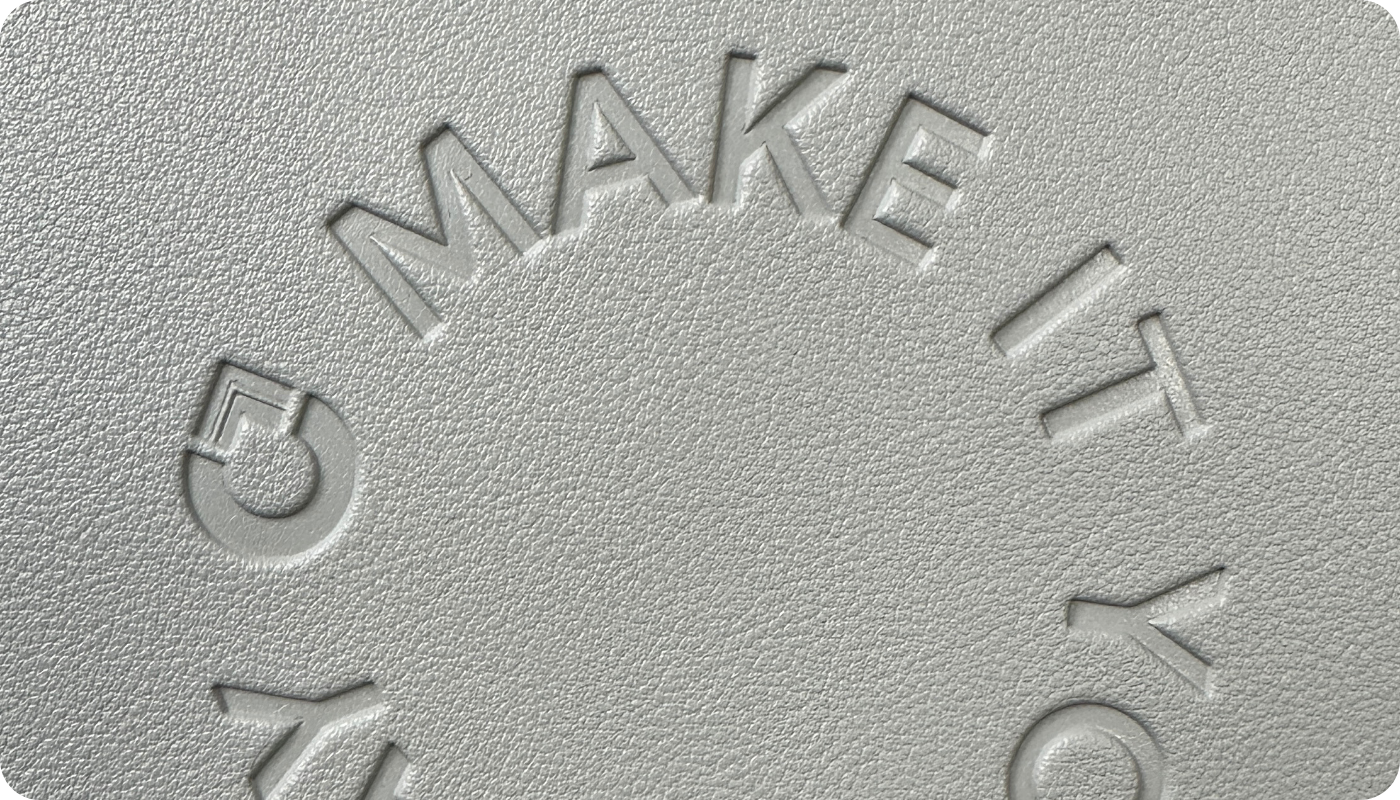Debossing

Debossing is a popular customization method where a design is pressed into the surface of a material to create a recessed impression. Unlike embossing, which raises the design above the surface, debossing sinks it below the surface for a subtle, tactile effect.
You can use debossing to personalize notebooks, leather / vegan leather goods, and other products where a refined, understated design is desired. It’s often paired with techniques like hot foil stamping to add an eye-catching metallic color to the recessed areas.
In this guide, we’ll explain how debossing works, what materials it can be used on, and why it might be a great finishing choice for your products.
What is debossing?
Debossing is a decoration technique that uses a metal plate (called a “die”) and pressure to press a design into a material, leaving an indented impression.
It produces a sleek, minimal impression that you can both see and touch.
What is blind debossing?
Blind debossing is debossing without the use of additional foil, ink, or color. The design relies entirely on depth and shadow for its effect, creating a subtle, tone-on-tone finish.
How does debossing work?
The debossing process is relatively simple. Here's a step-by-step breakdown:
- A custom metal die is created with your desired design.
- The die is pressed into the product using heat and pressure.
- The result is a recessed design that sits below the material’s surface.
What materials does debossing work on?
Debossing works best on materials with enough thickness and structure to hold the impression. Common options include:
- Paper and cardboard (business cards, packaging, stationery)
- Leather and PU leather (wallets, journals, accessories)
- Certain plastics and coated materials
Advantages and disadvantages of debossing
Here's a complete breakdown of the advantages and disadvantages of UV printing compared to other traditional printing methods.
Advantages
- Premium appearance – Debossing gives products an elegant, tactile finish that’s strongly associated with high-quality goods and craftsmanship.
- Durability – Because the design is pressed into the material itself, it won’t rub off, peel, or fade over time, making it ideal for long-lasting premium items.
- Versatility with finishes – Debossing can be used alone for a subtle “blind” deboss, or paired with foil stamping or ink for added color and contrast.
Disadvantages
- Higher setup costs – Each design requires a custom metal die, which adds to the initial cost. For smaller orders or short runs, debossing is often less affordable compared to DTG or screen printing.
- Less economical for complex projects – While the per-unit cost becomes lower at higher volumes, detailed designs may require more specialized dies, adding to both time and cost.
- Limited detail reproduction – Very fine lines or small text may not translate clearly, since debossing works best with bold, simple designs.
- Material restrictions – Thin or very flexible materials don’t hold impressions well, so debossing is usually limited to thicker paper, cardboard, leather, and similar materials.
- No inherent color – Blind debossing only creates depth, not color. To make designs stand out more visibly, an additional process like foil stamping is usually required, which may increase costs.
What kinds of designs are suitable for debossing?
Debossing works best with bold, uncomplicated artwork that emphasizes shape and depth rather than color. Because the technique presses the design into the surface, the impression is most visible and tactile when the lines are clear and the elements are not overly thin.
- Logos and monograms – Simple brand marks, initials, or icon-style logos translate very well into debossing. The recessed finish highlights clean geometric forms or strong lettering.
- Typography – Large text, short taglines, or bold typefaces create strong impressions. Fine print or very small fonts may lose clarity, especially on textured materials.
- Borders and patterns – Simple frames, geometric shapes, or repeating motifs can add subtle decorative detail to packaging, stationery, or leather goods.
Highly intricate illustrations, gradients, or designs with very fine details are less suitable for debossing. The process flattens very thin lines and can blur delicate features, so designs should be simplified to ensure they remain legible once pressed into the material.
What kinds of products can be debossed?
Debossing is commonly used on:
- Premium packaging (boxes, hang tags)
- Notebooks and journals
- Wallets, cardholders, and other leather goods
- Business cards and stationery
Debossing gives products a subtle, high-end touch that signals quality and attention to detail.
FAQs about debossing
Can debossing be combined with foil or ink?
Yes. Debossing can be paired with foil stamping (often metallic or colored foils) or spot ink to add contrast. This combination highlights the recessed design while keeping the tactile effect.
Is debossing more expensive than printing?
Generally, yes. Debossing requires a custom die, which adds upfront setup costs. For large production runs, the per-unit cost becomes much more affordable, but for smaller runs, other customization methods are usually cheaper.
What’s the difference between debossing and embossing?
Debossing presses a design down into the material, creating a recessed impression. Embossing does the opposite, raising the design above the surface.
Is debossing eco-friendly?
Blind debossing doesn’t require inks or solvents, which makes it a lower-waste alternative to some printing methods. When foils or inks are added, however, the environmental impact increases.